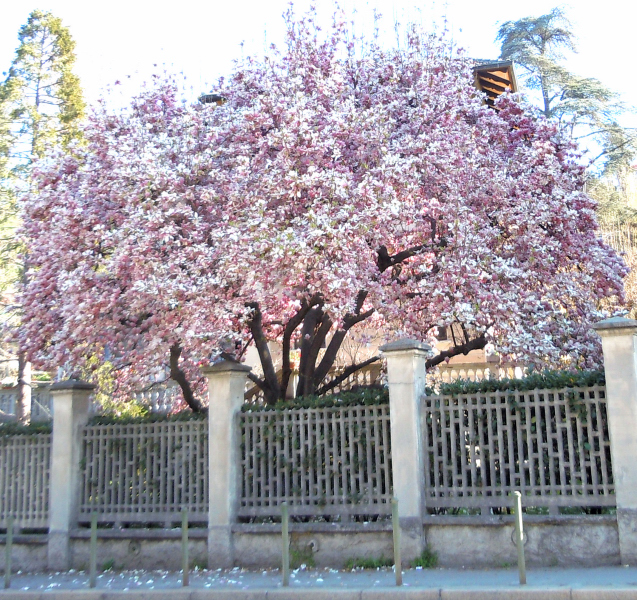The Magnoliaceae family is a group of plants that includes about 8 genera and over 200 species, primarily found in temperate and tropical regions of Asia, North America, and South America. This family is famous for its large, showy flowers and aromatic properties. Magnolia is the most well-known genus in this family, which includes the famous Magnolia grandiflora (southern magnolia) and Magnolia stellata (star magnolia), both popular as ornamental trees in gardens and landscapes.
General Description
Plants in the Magnoliaceae family exhibit the following characteristics:
- Leaves: The leaves are typically simple, alternate, and large, often glossy. They can be broad and ovate to elliptic, with a smooth or slightly serrated margin. Many species have deciduous leaves, while some are evergreen.
- Flowers: The flowers of Magnoliaceae are large and showy, often fragrant, and are usually borne singly. They are characterized by their large petals and a distinct, spiral arrangement of floral parts. Magnolia flowers can be white, pink, purple, or yellow, depending on the species. They have an ancient, primitive flower structure that is thought to resemble early angiosperms (flowering plants).
- Fruits: The fruit is typically a large, cone-like aggregate of follicles that contain seeds. The seeds are often bright red and are dispersed by the wind or by animals.
- Growth Habit: Magnoliaceae plants are generally trees or shrubs, with a wide variety of growth habits. Some species grow as large trees, while others are smaller, bush-like shrubs.
Chemical Composition
The plants of the Magnoliaceae family contain a variety of bioactive compounds, many of which have medicinal and aromatic properties:
- Alkaloids: Some species, such as Magnolia officinalis (magnolia bark), contain alkaloids, including magnolol and honokiol, which have been studied for their calming and anti-inflammatory effects.
- Flavonoids: Flavonoids, which are antioxidants, have been found in the leaves and flowers of several magnolia species. These compounds help neutralize free radicals and may help reduce the risk of chronic diseases.
- Essential Oils: The flowers and bark of magnolia species contain essential oils, which are often used in aromatherapy for their relaxing and soothing properties.
- Lignans: Magnolia officinalis is also known to contain lignans, compounds with potential antimicrobial, antioxidant, and anti-cancer properties.
Physical Properties
- Size: The plants in the Magnoliaceae family range from small shrubs to large trees. Some species, like Magnolia grandiflora, can grow up to 30 meters in height, while others, like Magnolia stellata, are much smaller and grow as shrubs or small trees.
- Flowers and Fruits: Magnolia flowers are large and conspicuous, with a distinct, often fragrant aroma. The fruit is a large, cone-like structure containing many seeds.
- Leaves and Stems: The leaves are large, simple, and often glossy, with a waxy coating on some species. The stems are woody and can be thick, especially in large trees.
Production and Harvesting
The Magnoliaceae family is cultivated for ornamental, medicinal, and aromatic purposes:
- Magnolia (Magnolia spp.): Magnolia species are widely grown for their large, showy flowers, which bloom in the spring. They are cultivated in gardens, parks, and as street trees for their beauty and fragrance.
- Magnolia Bark (Magnolia officinalis): The bark of Magnolia officinalis is harvested for medicinal purposes. It has been used in traditional medicine for centuries, particularly in Chinese herbal medicine, for its calming and anti-anxiety properties.
Applications
Medicinal
Some species of Magnoliaceae are used in traditional medicine, particularly for their calming and anti-inflammatory effects:
- Magnolia officinalis (Magnolia Bark): The bark of Magnolia officinalis has been used in traditional Chinese medicine for centuries. It is believed to have a calming effect, reduce anxiety, and help with digestive issues. Magnolol and honokiol, compounds found in magnolia bark, have been studied for their anti-inflammatory, antimicrobial, and potential anticancer properties.
- Antioxidant and Anti-inflammatory: Some magnolia species contain compounds like flavonoids and lignans that may have antioxidant and anti-inflammatory effects, helping to reduce oxidative stress and inflammation in the body.
Ornamental
Magnolia species are widely cultivated for ornamental purposes due to their large, fragrant flowers:
- Magnolia grandiflora (Southern Magnolia): This large tree is known for its striking white flowers and evergreen leaves. It is often planted in large gardens and used in landscaping.
- Magnolia stellata (Star Magnolia): This smaller tree is known for its star-shaped white flowers that bloom in early spring, before the leaves appear. It is commonly used in gardens and as a decorative shrub.
- Magnolia x soulangeana (Saucer Magnolia): A hybrid magnolia that has large, pink to purple flowers and is widely cultivated as a garden ornamental.
Aromatic
The flowers and bark of many magnolia species are used in perfumery and aromatherapy:
- Essential Oils: Magnolia flowers and bark contain essential oils that are used for their relaxing and soothing effects. These oils are often used in aromatherapy to reduce stress and promote relaxation.
Environmental and Safety Considerations
While Magnoliaceae plants offer many benefits, there are some important considerations:
- Toxicity: Although magnolia flowers and bark are generally safe, certain species, especially those with high concentrations of alkaloids, should be used with caution in medicinal preparations. The seeds of some magnolia species are toxic if consumed.
- Sustainability: Overharvesting of wild magnolia bark for medicinal purposes can threaten wild populations. Sustainable harvesting and cultivation practices are essential to ensure the continued availability of these plants for medicinal and ornamental use.
INCI Functions
- Anti-inflammatory: Reduces inflammation and soothes irritated skin.
- Antioxidant: Helps protect the skin from oxidative damage caused by free radicals.
- Relaxing: Used in aromatherapy for its calming and mood-enhancing properties.
- Antibacterial: Useful for treating bacterial infections on the skin.
Conclusion
The Magnoliaceae family, particularly the Magnolia genus, is widely recognized for its ornamental beauty, large fragrant flowers, and versatility in landscaping. Species like Magnolia grandiflora (southern magnolia) and Magnolia stellata (star magnolia) are popular choices in gardens and parks. Some species, like Magnolia officinalis, are also valued in traditional medicine for their calming, anti-inflammatory, and antioxidant effects.
![]() Magnolaceae
Magnolaceae 

